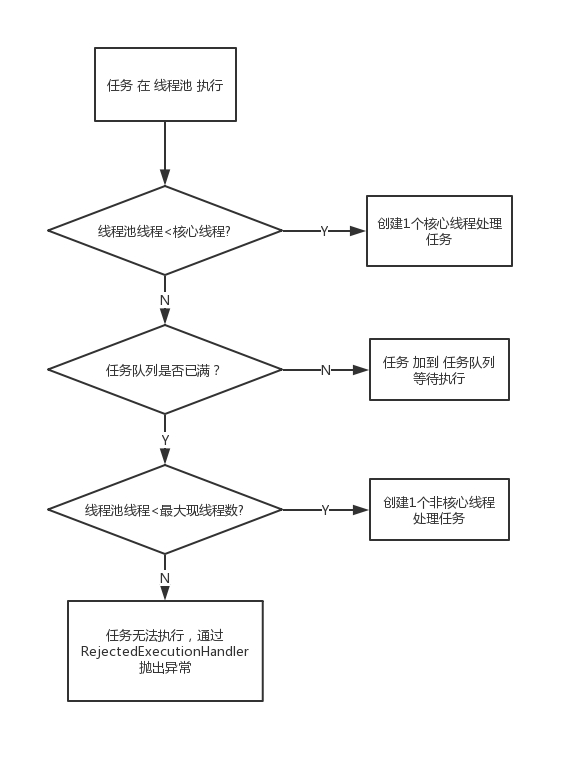记录一次电话面试
线程安全问题
1、问题描述
为什么java有多线程安全问题?JavaScript、Redis却没有线程安全问题?
2、我的回答
因为java中允许多个线程可以共同操作某个对象。
在线程模型中,多个线程可以操作共享对象,假设一个线程A将共享对象从1变成2,而另一个线程在操作共享对象时,还认为共享对象是1,这样就可能带来程序错误。
3、对方的回答
他对我的回答还是不满意,告诉我是因为cpu中间有缓存。
这样我意识到每个线程在操作共享对象时,可能操作的是cpu中的缓存对象,而不是堆中的对象。这样一个线程修改cpu中缓存对象,没有及时的刷新到堆中;另一个线程也是在操作cpu中缓存对象,也不是操作堆中对象。
线程池相关
1、问题描述
假设线程池最大线程数为4,核心线程数为2,任务队列为3;假设第3个线程进来的时候,前俩个线程任务都没有完成。此时,新进来的第三个任务时,线程池会发生什么?
2、问题分析
其实这道题目就在问线程池的工作流程。我回答的很不对,他就立马问我在项目中是否用到线程池过。
唉,用是用过,但自己没思考那么仔细
3、问题答案
- 第一个任务直接创建新线程执行;
- 第二个任务也是直接创建新线程执行;
- 第三个任务是放在队列中,等到前俩个任务线程完成后才去执行
(1)总结一下线程池的工作流程:当一个任务提交的时候
- 如果线程池中线程数小于核心线程数,就会创建一个线程来执行任务;
- 如果线程池中线程数等于、大于核心线程数,就会把这个任务放在任务队列中;
- 如果任务队列已经满了的话,就执行拒绝策略

(2)从源码上分析:
// 以:ThreadPoolExecutor poolExecutor = new ThreadPoolExecutor(2,4,20,SECONDS,new ArrayBlockingQueue<>(3));为例
// 核心过程是在 ThreadPoolExecutor的execute方法
/**
* Executes the given task sometime in the future. The task
* may execute in a new thread or in an existing pooled thread.
*
* If the task cannot be submitted for execution, either because this
* executor has been shutdown or because its capacity has been reached,
* the task is handled by the current {@code RejectedExecutionHandler}.
*
* @param command the task to execute
* @throws RejectedExecutionException at discretion of
* {@code RejectedExecutionHandler}, if the task
* cannot be accepted for execution
* @throws NullPointerException if {@code command} is null
*/
public void execute(Runnable command) {
if (command == null)
throw new NullPointerException();
/*
* Proceed in 3 steps:
*
* 1. If fewer than corePoolSize threads are running, try to
* start a new thread with the given command as its first
* task. The call to addWorker atomically checks runState and
* workerCount, and so prevents false alarms that would add
* threads when it shouldn't, by returning false.
*
* 2. If a task can be successfully queued, then we still need
* to double-check whether we should have added a thread
* (because existing ones died since last checking) or that
* the pool shut down since entry into this method. So we
* recheck state and if necessary roll back the enqueuing if
* stopped, or start a new thread if there are none.
*
* 3. If we cannot queue task, then we try to add a new
* thread. If it fails, we know we are shut down or saturated
* and so reject the task.
*/
int c = ctl.get();
// 如果线程池数 < 核心线程数
if (workerCountOf(c) < corePoolSize) {
if (addWorker(command, true))
return;
c = ctl.get();
}
// 如果线程池数 >= 核心线程数:
if (isRunning(c) && workQueue.offer(command)) {
int recheck = ctl.get();
if (! isRunning(recheck) && remove(command))
reject(command);
else if (workerCountOf(recheck) == 0)
addWorker(null, false);
}
else if (!addWorker(command, false))
reject(command);
}
(1)线程池数大于等于核心线程数,不一定就会放在队列中
这里会采用double check,在放入队列之前,有一个线程正好完成任务的话,就用这个线程来执行了。
线程安全容器
1、问题描述
jdk1.8的ConcurrentHashMap锁加在哪里?
2、问题答案
是在每个Entry上加锁,也就是对Entry下面的链表或者红黑树加锁。
他又问我具体的加锁的情况:当一个线程在Entry01下的链表或者红黑树进行put操作时,其他线程如果也要这个Entry01的链表或者红黑树进行操作时,就会阻塞住,等待上个结束为止,他才能进行操作。
其实他问我
ConcurrentHashMap很多问题,但我刚开始一直在说jdk7和jdk8的区别。以至于后面我还问他上面问题是基于jdk8的把,他说现在都用jdk8,当然问jdk8。这也告诫我,除非下次别人问我ConcurrentHashMap在jdk7和jdk8的区别,否则我就直接说jdk8的情况就好了。关于上锁时机和情形,当时回答不是很好把。他说下周来公司面试之前,好好看看
ConcurrentHashMap,到时候会好好问这个的~
用过哪些中间件
问我用过哪些中间件,我说对Redis比较熟。他就问我用Redis的哪些功能,我说用它做过主从同步。
他就让我说说是怎么做的?我说假设开三个Redis实例,对其中俩个实例使用slaveof+主节点的ip+端口。然后在应用中,凡是写操作就向主节点写,凡是读操作就往从节点读。
他又问我Redis主从同步是用什么实现的?我懵了,就说不会。
后来查了一下,有全量同步和增量同步俩种方式。但我觉得他意思应该不是问这个把?大佬们,求解?
他问Redis事务有用过吗?我说看过这方面的书,但在项目上没使用过。他就没问了。
其他
面试结束的时候,他问我有什么问题要问的?我问了:像我平常使用Redis的其他功能比较少,那我应该怎么学习它?
他告诉我:当你在项目中使用某个技术之前,你应该已经掌握这个技术的所有功能
他说很简单,如果你不全面了解这个技术的功能,你怎么知道在什么应用场景下,使用什么功能呢。比如说,先把Redis的功能全部都理解一遍,以后遇到实际应用问题时,你才知道选择什么功能来解决。

